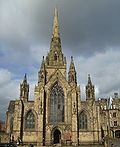| St Mark's Church | |
|---|---|
 St Mark's Church, Worsley | |
 | |
| 53°30′07″N2°23′06″W / 53.502°N 2.385°W | |
| Location | Worsley, Greater Manchester |
| Country | England |
| Denomination | Anglican |
| Website | St Mark's Church |
| History | |
| Status | Parish church |
| Dedication | St Mark |
| Consecrated | 2 July 1846 |
| Architecture | |
| Functional status | Active |
| Heritage designation | Grade I |
| Designated | July 1966 |
| Architect | George Gilbert Scott |
| Architectural type | Church |
| Style | Gothic Revival |
| Groundbreaking | 1844 |
| Specifications | |
| Materials | Sandstone |
| Administration | |
| Province | York |
| Diocese | Manchester |
| Archdeaconry | Salford |
| Deanery | Eccles |
| Parish | Worsley |
| Clergy | |
| Rector | Revd. Adam Whittle |
St Mark's Church is an active Anglican parish church in Worsley, Greater Manchester, England. It is part of a team ministry along with St Mary's in Ellenbrook and St Andrew in Boothstown. The church is in the Eccles deanery, the archdeaconry of Salford and the diocese of Manchester. [1] The church was granted Grade I Listed status in 1966. [2]




